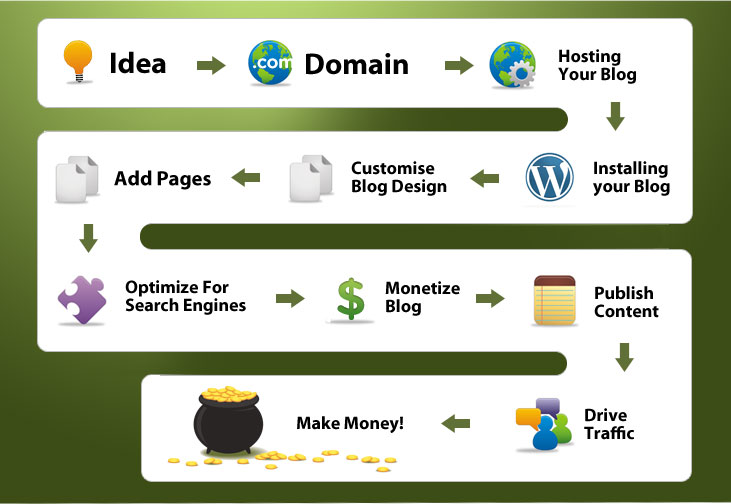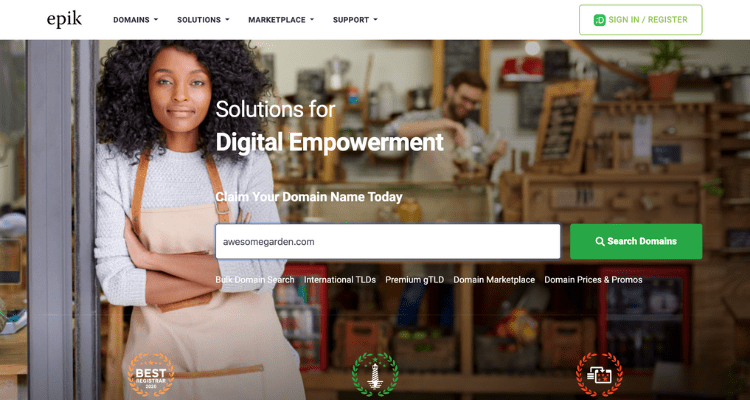
Is it still worth creating a website?
Even in 2024?
Of course, it’s worth creating a website. You are on one right now, so you must appreciate its importance. In the last decade, a lot has changed in the world of website creation, yet so much has stayed the same. This guide is dedicated to those first starting their website, with all the tips and tricks we wish we had when we first started.
The website you are on now is considered a blog. And since the inception of blogging, millions of blogs have appeared and collectively made billions of dollars. (perhaps even Trillions!)
And if you’re reading this, you’re probably wondering if blogs can still make money.
The answer?
A resounding, YES!

What’s included in our guide to creating your first website:
If all you have right now is 20 minutes and $5, you could choose a name, get hosting, setup website and customize your design.
- 1. Get a domain name (5 minutes)
- 2. Get website hosting (5 minutes)
- 3. Install WordPress (5 minutes)
- 4. Customize your website design (5 minutes)
- 5. Creating content for your new website that will attract visitors
- 6. Optimize Your Website For Search Engines
- 7. Promote Your Blog
- 8. Remain Consistent
- 9. Pivot Through Failure To Achieve Success
- 10. Don’t Forget About Your 9 to 5
- 11. Save Money & Pay For Help
- 12. Quality Over Quantity
- 13. Earn As Many Relative, Quality Backlinks As Possible
- 14. Focus On User Experience
- 15. Monetize Your Content
Estimated completion time: 3 hours
How much money can you make from creating a website?
My usual answer is from Zero to Millions…
But let’s qualify that.
Most people earn nothing or very little. (Sorry!)
But I am guessing if you are reading this, you don’t want to fall into that category?
While the majority may not make it, there is a significant minority who do go on to make a significant income.
Earning enough to replace the 9 – 5 income is certainly possible.
Realistically (with application) a 4 or 5 figure monthly income is possible in your first year.
And within 2 or 3 years you could be producing a substantial 6 figure annual income. (even 7 figures).
So YES, you can still make money blogging!
Everything you need to know about creating a website
First things first…
The basics of launching a blog have changed little and if you are already a blogger, you will be familiar with the first 4 points below.
What has changed, however, is the implementation of those “basics”.
1. Decide what your website is going to be called
(and find a good domain name to go with it)

When I create a website, I don’t begin until I’ve found a domain name I think is good enough.
Sometimes it makes sense to buy a domain that has already been registered from a Domain Broker.
For example, IncomeDiary.com was bought for $100 from a fellow blogger.
Keep in mind the following questions when deciding on a name:
- Does it reflect what your blog is going to be about?
- Would your target audience like it?
- Is the name easy to say and spell?
- Is it short and concise?
I recommend opting for a .com whenever possible and keeping it to three words or less.
You can register your domain name from the following, trusted registrars: HostGator
The aforementioned three registrars are established, secure and non-partisan.
Once you’ve got your domain name secured, it’s time to connect it to the world wide web.
2. Get website hosting
Now that you’ve chosen a catchy name for your blog, it’s time for step 2.
You need to sign up for a web hosting service to get your blog live and connected to the internet.
We confidently recommend the following, secure, fast, and non-partisan web hosting companies:
| Host | Bandwith | WordPress | Free Domain | Live Chat | Price |
| HostGator | Unmetered | Yes | Yes | Yes | $3.75 |
| BlueHost | Unmetered | Yes | Yes | Yes | $1.99 |
| Nexcess | 2TB bandwidth | Yes | No | Yes | $21 |
| WordPress.com |
Unmetered |
Yes |
Yes |
Yes |
$5.00 |
 |
Get 70% discount on your HostGator hosting with this coupon: SNAPPY |
You’re doing great!
Now it’s time to install WordPress.
3. Install WordPress

You have your web host, next you need blogging software.
Most modern blogs are run on a CMS (content management system) known as WordPress.
I trust WordPress to run all of my blogs as it is user-friendly, feature-rich, and free.
If I had never created a website before and had just bought a domain and hosting, I would go straight on my hosts live chat and say the following:
Hi,
I just purchased hosting from you for website.com (your website URL)
I would greatly appreciate it if you could install WordPress on it as soon as possible, as I’m eager to start using it immediately.
Thanks,
Note: Most hosts offer 1-click installation for WordPress these days. Meaning you don’t have to worry too much about the technical side of things.
Once you’ve got WordPress installed, it’s time to design the look of your website.
4. Customizing your website design
To design a blog, you need to select an attractive and affordable WordPress theme.
Why do you need this?
Well, after signing up for WordPress, your blog will look very boring and empty.
You want it to be engaging by having an organized structure and visually appealing layout.
For this, we recommend that you go to ThemeForest, they have a catalog of thousands of different website designs to choose from. Alternatively, if you want someone to design your website for you, you could consider WordPress’s design services.
Now that you’ve got your site design applied, it’s time to begin creating content.
5. Creating great content
Some say,
“Write about what you love and you’ll never work a day in your life.”
OK, I may have tweaked that statement a bit to fit my narrative, but you get the idea.
Old wisdom would have you pick what you are most passionate about, then build a blog around it.
As we mentioned above, this is not a terrible idea.
But it is not a great idea either!
The problem with this approach is that what we love doesn’t always put money in the bank.
Rather, focus on solving problems for your readers.
Blog about issues that your readers are actively seeking to solve.
These topics are more likely to end up making you money.
New website owners have a big problem though: they need to generate massive amounts of content to generate vast amounts of traffic. When I first started my blog, it took me about a year to write 100 articles. That was 15 years ago, though; you only need an idea and AI to create content quickly. Take a look at a great tool called ContentShake AI. All you have to do is choose a content idea, and it generates a full article optimized for users and search engines.
They have a free seven-day trial, so you could try it out and generate 25 articles. If it’s not for you, cancel, and you walk away with 100,000 words written for free.
Special Note: When creating content for our site, we find it best to first come up with a headline and then build around that.
Related Article: 10 Writing Tips for Writing Engaging Content Your Readers Will Love.
6. Optimizing Your Website For Search Engines
If you want to earn money through blogging, search engine optimization (SEO) is crucial because, for most bloggers, it’s their biggest traffic source. Without it, your chances of making money become highly improbable. The goal of SEO is to optimize your website so that it ranks higher in search engines for specific keywords and phrases.
To optimize your WordPress blog, you can use a Yoast SEO plugin. To download it, go to the Plugins menu, click Add New, search for Yoast SEO in the search bar, and install and activate it. This plugin will provide many improvement tips and suggestions based on the keyword you select to help optimize your content. Incorporating as many suggestions as possible can help improve your SEO and content readability.
There are over 100 different ways to optimize a website for search engines; the most important five are below:
- Name your posts, and provide the URL of the keyword you want to rank for in Google. For example, this article is called Create a Website, and the URL is infomediary.com/create-a-website.
- Build as many backlinks as possible. The best way to get links is to create great content and to network.
- Link all your articles together using the keyword you want to rank high in Google. For example, above, I mentioned backlinks, and that link takes you to my article on backlinks. This reinforces the subject of the content to Google.
- Publish lots of content. More content means more opportunities to get high rankings in Google, more chances for someone to link and share your content, and more chances for interlinking content on your site.
- Keyword research is probably the most important thing. Keyword research involves discovering how much traffic a search term gets in Google and then optimizing your website for that keyword. If you don’t do this, the keywords you are targeting could have low search volume, meaning all your work is for nothing.
8. Remain Consistent
“Find a schedule that works for you and keep at it through thick and thin.”
Today, more than ever consistency is still key. However, the problem with the above advice is that it gives the impression you can follow an arbitrary schedule and expect positive results.
Big mistake.
Instead, you may want to stick to consistently publishing high-quality posts.
For instance, Orbit Media has found that blogs that publish consistent daily posts almost always see more success [1].
This is The Most Advanced Blogging Strategy I’ve Never Shared.
9. Pivot Through Failure To Achieve Success
“Don’t mind failure and continue what you’re doing. Eventually, you’ll find success.”
This advice is similar to “remain consistent” in that it suggests not making any changes despite the obvious loss or absence of traffic to your site.
This is a surefire way to drive your fledgling blog into the ground.
While there’s merit to sticking to your guns, sometimes you need to accept you’re doing something wrong.
The term pivot has become very popular, and for good reason.
As an entrepreneur, you are going to pivot often to remain on top of trends and keep things fresh.
Blogs have to keep pace with constantly-changing SEO (search engine optimization) and UX (user experience) standards if you want lasting web traffic.
10. Don’t Forget About Your 9 to 5
“Building a blog needs you to go all in. Forget about your job and take the plunge.”
Building a blog requires a lot of time and effort if you want it to be successful.
The problem is that most people can’t afford to immediately quit their day job to write about their passions.
It’s a recipe for disaster.
Consider leveraging your current profession rather than abandoning it.
If you’re a paralegal, make a blog that helps answer people’s legal questions.
Or maybe you’re a full-time mom. Write about parenting and keeping kids entertained.
Perhaps you’re a mechanic, write about common modifications, problems, and solutions for the vehicles you work on.
The beauty here is that you can use the professional experiences you’ve established through your day job to enhance your blog.
Keep in mind that people resonate with real; so don’t lie and don’t pretend to be something you’re not.
Authenticity and transparency are two of the most important ingredients for online success.
Related: 10 eCommerce Trends Every Blogger Needs To Know About!
11. Save Money & Pay For Help
There’s nothing wrong with building your blog from the ground up yourself.
But if you’re a beginner, you may run into problems that are too big or complex to solve on your own.
It happens to ALL of us. (one of the advantages of the training we recommend is that it also gives you access to a private Facebook Group where you can ask questions about any challenges you may have)
This is why business-minded people treat a blog as a startup and outsource many of the processes to specialists.
By outsourcing your blog’s design, structure, content, social media growth, etc. you’ll have more time to spend doing everything else (like promoting your content) to make it successful.
12. Quality Over Quantity
Many blogs of the past focused on publishing multiple short posts, sometimes several times per day, in an attempt to gain traffic.
This resulted in thousands of blogs spewing millions of posts with useless and unreadable content.
Many even resorted to plagiarism to fluff their daily post quotas.
Today content is king, especially since long-form content (posts over 1500 words or more) has been found to outrank those with 1000 words or less.
You want to engage with your users.
The more time users spend on your site, the more authority you display to Google and other search engines.
Additionally, modern search engines know which website published the content first and penalize those plagiarizing or spinning (rearranging content to avoid plagiarism detection).
Related Article: Creating Blog Posts 101
13. Get Quality Backlinks

One SEO trend in the 2010s was to get as many backlinks as you could – regardless of quality.
A backlink is a link on one website pointing to your website.
They can come from social media sites and directories, but they most often come from the content of other blogs.
The more backlinks you had, the more likely your blog was to show up at the top of Google’s search pages.
This trend gave rise to websites paying money to get more backlinks despite their questionable sources.
Times have changed and all major search engines are on to them.
These days, quality over quantity doesn’t just apply to the number of words and amount of time spent writing blog content.
It extends to the quality of your backlinks as well.
Getting higher quality backlinks (backlinks from high domain authority websites) means a bigger bump to your own site’s domain authority and search engine presence.
Also, if you’re running a blog about organic gardening, getting backlinks from an automotive website doesn’t do you much good.
Search engines won’t reward you for it.
Today there’s not much argument over whether it’s better to have more backlinks or quality backlinks.
Quality wins.
This SEO Starter Guide from Google is a good place to start if you are a beginner.
Related Article: How to get backlinks in 2024
14. Promote Your Blog
There are thousands of ways to boost website traffic, but the best is by trying something proven.
Listed below are several of the methods that currently work for attracting not only attract new users to blogs, but keep those users on the site and returning for more.
Let’s break this down into separate categories, Onsite and Offsite.
Beginning with onsite promotion:
- Resource page – Top content located in one place
- Thank you page – Encourages trust and support
- Favorite products page – List your favorite in house and affiliate products
- Repurpose Your Content – Turn your top blog posts into infographics, podcasts, and videos
- Host A 30 Day Challenge – Gets people sharing your stuff and returning for more
- Interview Thought Leaders – Positions you as an authority and encourages quality backlinks
- Run A Contest Or Giveaway – Great way to get email subscribers and social shares
- Sell An Ebook of Your Best Posts – Take your most popular posts & package them into a PDF to sell
- Require Shares for Bonus Content – Lock content until a user shares it with social media
- Experts Contribute to Roundup Post
Now let’s discuss offsite promotion: (and assuming you are producing quality content)
- Ad Swaps – cross-promote a competitor or relevant business
- Use Sniply – Add a call-to-action to every link you share
- Social Media – Publish Images, videos, & in-depth posts with links to your site
- Use QR Codes – Use with any offline medium; T-shirts, posters, flyers, or even billboards
- Sending Emails – Begin building your email list with how we use Omnisend and send emails with MailChimp.
- Submit to Quora – People worldwide have questions you can answer with your content.
- Wear & Sell Brand Swag – Connect with a dropshipping service like Printify and model your own gear
- Posting to Medium – republish your existing content and expose it to new readers
- Answer Questions On HARO – Reporters request an expert quote, opinion, or story, then provide free publicity for their contributors
- Drive Traffic With Your Email Signatures – Add a link to a popular page or post in every email footer
- Include A Custom Link On Business Cards – Create a link with an intriguing headline and short URL to capture attention.
15. Focus On User Experience

Another trend for the early 2010s was the single-minded focus on a blog’s SEO rankings.
Many people created content to please search engines rather than their users.
This trend led to an influx of sites with poor-quality content ranking high on search engines.
That no longer works!
Search engines can tell if your content is plagiarized, keyword stuffed and overall low quality.
There are several metrics that reveal this.
For instance, the amount of time a user spends on your site, how far they scroll down a particular page, and how many other pages they view all factor into your ranking and perceived quality.
Today, you’ll find that SEO trends focus heavily on quality user experience.
15. Monetize Your Content

Now it’s finally time to make money on your content!
There are multiple ways to go about this.
Here are the most common:
- Search Ads
- Online Shop
- Sell A Service
- Affiliate Links
- Software Sales
- Resell Products
- Content Lockers
- Sell Advertising Space
- eBooks/Digital Products
Let’s break each one down…
Search Ads
Search networks are among the best places to advertise.
The search network is simple:
Someone heads to Google and searches for a topic related to a burning pain point or need.
Then, they click the ad and fill out the form or purchase the product directly.
Search ads are best when you want to capture intent.
Online Shop
You can utilize a service such as Shopify (non WordPress) which is an out-of-the-box storefront you can add a blog to.
We like WordPress and selling things in-house.
If this is the route you’d like to go as well, you can simply install the WooCommerce plugin, and immediately list products.
You can also integrate with a service such as SamCart or OptimizePress which will also allow you to list and sell your own products in-house with custom checkout pages.
WooCommerce, SamCart, and OptimizePress fully integrate with WordPress and Stripe (payment processor that accepts credit cards).
Sell A Service
Depending on the topic of your blog you could accept payment for a service.
Whether your service is physical or digital, you can add a payment link via:
Affiliate Links
This is the classic, and a method you’re likely familiar with.
There are literally thousands of affiliate networks available online.
In fact, nearly every major brand has some sort of affiliate program.
Just go to your preferred search engine, and type the name of your brand, followed by “Affiliate Program.”
What you will find is that most companies use a 3rd party to handle affiliate sales.
You may find yourself redirected to one of the following networks:
Software Sales
Does your blog utilize, discuss or provide a certain software?
Maybe you need one that doesn’t exist yet – hire somebody from Upwork and create it.
You can then use your blog to drive traffic to your SaaS (software as a service) product.
How to make money blogging reselling products
This one has been a pillar in the offline world for decades.
Buy low and sell high.
If your blog revolves around a topic that also has physical products related to it, see if you can find those products at a discounted rate, and sell them for full price or higher.
Content Lockers
This is one that gained a ton of notoriety in the early 2010s and slowly tapered off.
However, they do still work.
There are companies like CPAlead and PayWithAPost that will allow you to have a popup block content until the user takes a survey, shares the content, opts-in, or pays a fee.
While I personally don’t like this approach, there is no doubt that for some niches this still works well.
Purchase Display Ads
While the search network has keyword intent, the display network doesn’t.
Display networks (think Facebook, Instagram) work to create demand rather than answer demand like search networks.
The display network helps to cultivate a feeling of want and need rather than instantly capitalizing on a want or need that already exists.
You reach users on the display network when they are browsing different sites and forums.
This means that they aren’t actively looking for your product (yet).
Instead, they are researching their options.
They’re seeking the best fit to solve their problem



0 Comments